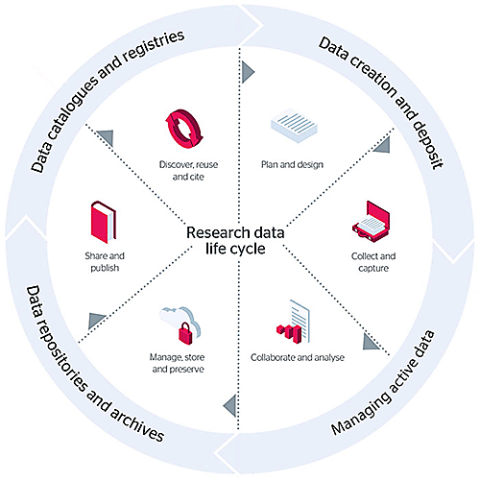What is research data?
In a nutshell, research data is information (in any format) that you collect during the course of your research and from which you draw conclusions or make inferences. It can range from raw measurement data collected in a spreadsheet, to transcribed interview text, to qualitative observational data ... the list is endless!
The University’s Research Data Management Policy (page 7) provides a more detailed definition. You may also find the definitions adopted in the UKRI's (formerly RCUK) Concordat on Open Research Data (page 3) useful.
What is RDM? (a.k.a “What’s in it for me?”)
Your research data is extremely valuable; both to yourself as an individual and the research community, and wider society as a whole. So it is important to take good care of it.
Research Data Management (RDM) is about efficiently organising data in your project. It is concerned with the creation, processing and preservation of your data during the lifetime of your project and beyond. It’s an umbrella term for a group of actions and processes, some of which you probably already engage with, for example:
- Using data formats that can be easily accessed and shared.
- Controlling file versions.
- Organising your files and storing them securely.
- Backing up your data to prevent loss.
- Controlling access to data, particularly personal data.
- Documenting processes, analytical methods and issues with the data (i.e. metadata) to allow your work to be verified by others (...or to remind yourself what you actually did!).
- Depositing/archiving data at the end of project to enable it to be shared and made open access wherever possible.
When do I need think about RDM?

(JISC, 2016)
You might think of RDM in three phases during the lifecycle of your project:
- At the start of your project, while planning and mapping out how you intend to create, process and preserve your data.
- During the project, where you manage your data on a day-to-day basis, documenting processes and revising your plan if necessary.
- At the end of the project, to ensure that the data and metadata to be archived (and made open access whenever possible) is fit for purpose.
Why is open science and data sharing important?
With the increasing international momentum towards open science, there is growing emphasis on openly sharing data and publications. Sharing research data enables the widest benefits to be gained from the data - for other researchers, businesses and the wider benefit to society at large. Given that the majority of research is funded with public money, it’s only reasonable to share the data produced.
Sharing research data also has direct benefits to you:
- For research integrity and transparency - it allows you to verify the processes and conclusions drawn by other researchers (and likewise allows other researchers to verify your research).
- It makes your outputs more visible and potentially improves citation rates (see Piwowar & Vision, 2013).
- It enables collaboration by facilitating the reuse and sharing of data, and avoiding the duplication of work where possible.
...and good RDM practice in general also benefits you:
- It reduces the risk of inadvertent data loss / unintended disclosure.
- It helps continuity within the project should team members leave / new members join.
These significant benefits have been recognised by national and international organisations. Therefore it’s increasingly a policy requirement and expectation of major funders, institutions and publishers that (wherever possible) research data is shared publicly and made open access at the end of a project. Effective data management is necessary to make that happen.

